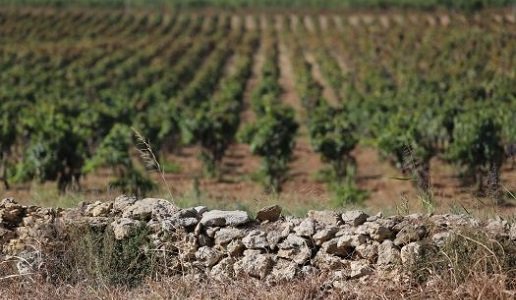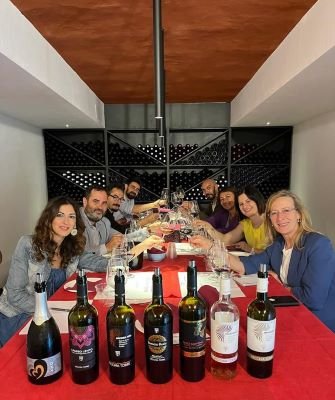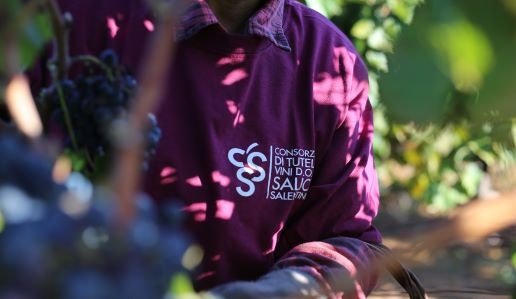A press tour organized by the Consortium of Salice Salentino allowed us to become better acquainted with this land and learn more about the path laid out by the producers for its wines.
From the Adriatic to the Ionian, from the province of Lecce to Brindisi Passing through the municipalities of Salice Salentino, Guagnano, Veglie, Campi Salentino, Cellino San Marco, San Pancrazio Salentino and San Donaci, you will discover a landscape of rare beauty dominated by dry stone walls and vineyards, the cradle of DOC wines Salice Salentino DOP and Salento Igp.
 Negroamaro is the main grape variety, with a small addition of Malvasia nera is the basis of most red and rosé versions, surprising and conquering even the most demanding palates and enhancing the most unusual pairings and meals from aperitif to dessert. These are powerful wines, deep and impenetrable in color with notes of black fruits, roasted coffee and goudron.
Negroamaro is the main grape variety, with a small addition of Malvasia nera is the basis of most red and rosé versions, surprising and conquering even the most demanding palates and enhancing the most unusual pairings and meals from aperitif to dessert. These are powerful wines, deep and impenetrable in color with notes of black fruits, roasted coffee and goudron.
Viticulture in Salento dates back to the time of the Greeks and, passing through the Romans, has come to our own time. The sea plays a determining and characterizing role, mitigating the climate, sanctioning the sapidity of the closest soils, bringing winds and scents, the soil in turn is distinguished by its sandy texture capable of giving rise to wines rich in extracts. This favorable pedoclomatic mix also makes the area suited to the production of great rosés: 1943 saw the birth of Leone de Castris’ Five Roses, the first rosé to be bottled in Italy and the first attempt in Puglia to combine product processing and bottling. A great challenge for the time.
Coordinated by the Salice Salentino Consortium, we had a nice tour among the producers in the area. This of Salice Salentino is a dynamic and enterprising Consortium, whose mission is to enhance and promote an area with a millenary winemaking tradition by adopting marketing and communication strategies in synergy with all the players in the economic fabric to trigger a 360° process of valorization and innovation. The consortium-founded in 2003 by a group of producers determined to give voice to the eponymous technical production specifications dated 1976 and reinforcing the inseparable binomial between terroir and vine – represents about 80 percent of the entire Salice Salentino supply chain with 42 wineries engaged in the production of 110 thousand hectoliters of wine resulting from 160 thousand quintals of grapes produced. Today’s chair is Damiano Reale.
Restyling of the specification is in progress, the request/need has come from the grassroots level i.e. from the producers. The minimum percentage of Negroamaro in reds and rosés increases from 75% to 85%. As for Salice Salentino white, Chardonnay, Fiano and Pinot Bianco are joined by Verdeca. They join charmat sparkling wines, the classic methods that must age at least 12 months in the bottle, including 9 months on the lees. Down to 18 months of aging for the Riserva mention (including at least 6 months in wood), and Salice Salentino Superiore Doc makes its entrance, which provides 12 months of aging, no specification on the type of aging and the possibility of mentioning the vineyard of origin on the label.
Teamwork and collaboration with other Consorzi di Tutela could lead to another important collective achievement in the area of Igt. From the Salento IGT specification it is clear that the production area includes the entire administrative territory of the provinces of Brindisi, Lecce and Taranto, it is possible to join the already existing denomination by shortening the time of the bureaucracy instead of establishing a new one.
The Salice Sal entino consortium already in 2014 under the presidency of Angelo Maci obtained the enlargement of the statute with the inclusion of the Igt Salento designation,” says Eugenio Manieri, agronomist and technical director of the Salice Salentino Consortium.. It was an ethical choice, the purpose of the current board of directors was to start a new path and promote our territory which for years has been gaining acclaim through its gastronomic excellence, its wines, its culture, its masserias, its coasts and its seas. Today we are focused on the PDO Salice Salentino wines that have obtainedErga Omnes recognition, if we can obtain it for the Igt Salento wines as well, we would all take an important step forward, within a short time we will achieve the representativeness of 40 percent of the winemakers. Joining forces is a common interest.”











